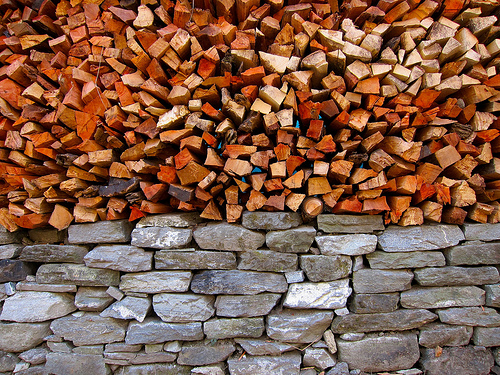Building a Fire to Improve Heat Efficiency
Sounds funny doesn’t it, learning how to build a fire. Can’t everyone build a fire? Probably. But, what most people don’t do is build a fire that can improve their heat efficiency.
Traditionally, a fire is built on a metal grate by stacking three or more logs with their sides facing the fireplace opening. Kindling or the gas line is ignited underneath the logs and near the back wall. What makes this an inefficient way to build a fire is the fact that the wood blocks the blaze and prevents the warmth from reaching the room you want to heat.
You can improve your heat efficiency by 100% without spending any extra money. All you have to do is stack the wood differently. It’s that simple.
Begin by placing some kindling in the middle of your fireplace grate. Then lay a split log, front to back, at each end on the kindling pile. The log end (not its side) should face the opening of the fireplace. The wood sections at the back of the fireplace should be closer together than the wood at the front. Its fine if the wood touches the back of the fireplace, but it should not extend more than an inch beyond the front of the grate or they may throw smoke out into the room.
Now lay one or two pieces of wood across the two side logs, pushing them to the back of the fireplace. If this reminds you of playing with Lincoln Logs then you’ve got the right idea.
There you have it! A wooden firebox that’s entirely open across its front. This allows a great deal of heat to radiate directly into the room because there are no large pieces of wood blocking the heat. It also allows air to be freely drawn up through the bottom of the grate since it isn’t blocked by tightly packed logs. This creates a good draft that makes your fire burn more efficiently.
As the top logs burn and fall into the center of the wooden firebox just replace them in the same arrangement. If you want a hotter blaze, shove some smaller pieces of wood right into the wooden firebox, parallel to the side logs.
In addition to increasing the efficiency of your fireplace, this method of “setting a fire” has another advantage: It allows you to burn green or damp wood because it “cures” as part of the firebox before becoming part of the blaze, which is great when winter wood stores may get damp from rain or snow.
Whether you use your fireplace as a major source of heat or to simply “take the chill off” on frigid winter evenings, it’s an idea worth trying. After all there’s nothing to lose … and, so much to gain…100% increased heat efficiency!
![]() photo credit: Andrew-Hyde
photo credit: Andrew-Hyde

Recent comments
Aenean nonummy hendrerit mauris. Phasellus porta.